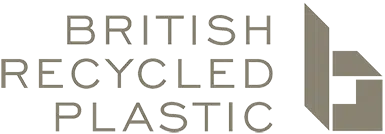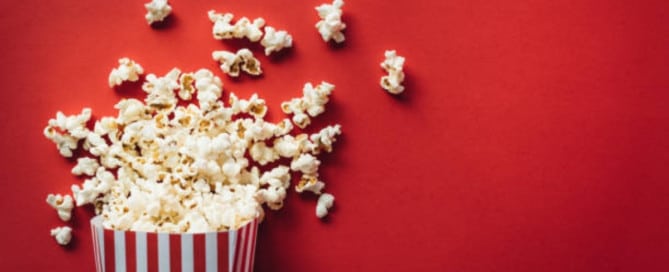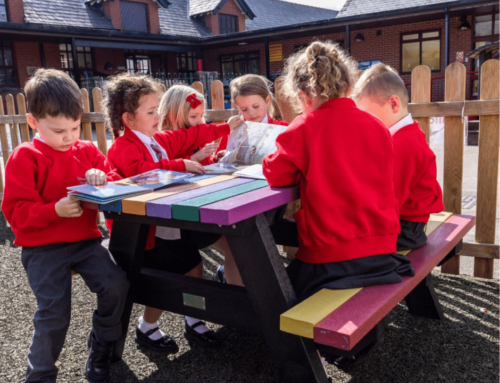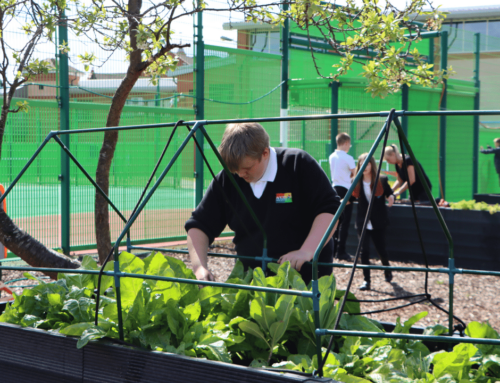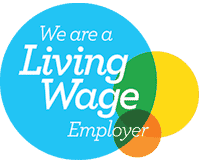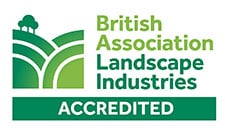Creating Packaging From Popcorn And Other Brilliant Ideas
It was a eureka moment: enjoying a tub of popcorn while settling in to watch the latest blockbuster at the local cinema.
It was while in the cinema that a German researcher realised popcorn had the exact same size and consistency as Styrofoam ‘packing peanuts’. And…the idea came to him to create an eco-friendly, biodegradable alternative.
Styrofoam is made from polystyrene, which requires fossil fuel extraction and takes centuries to break down into smaller pieces of harmful micro-plastic. Styrofoam is thought to take from between 500 years and forever to decompose.
As this type of plastic has only been manufactured for about 50 years, scientists have been creating experiments to ascertain its longevity. When exposed to ultraviolet radiation from sunlight, polystyrene’s polymer chains become brittle and start to crack. This suggests that this type of plastic will eventually fragment into microscopic granules. As of yet, however, scientists aren’t sure how many centuries it takes for the sun to ‘do its work’. According to some plastics experts, the ‘500 years – forever’ figures are another way of saying ‘a really, really long time’.
Fifteen million metric tons of polystyrene is produced globally each year. That’s a huge amount, especially as the product is around 95% air (and therefore weighs very little). It can be a popular choice for businesses as it provides excellent packing safety for fragile objects, while costing pennies to manufacture.
With all this in mind, German researcher, Alireza Kharazipour, thought it was worth experimenting with puffed corn kernels as a replacement for the Styrofoam ‘peanuts’. He now has a company creating packing which can be made from any type of corn, and it is completely biodegradable. Large pieces can be compressed into shapes to hold different products, and can be easily sawed into pieces, either for cutting into precise shapes, or for shredding at the end of its life.
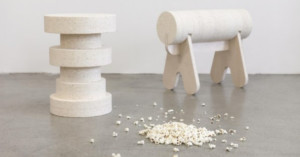
As we use recycled packaging to create our furniture and building products (more below), this ‘popcorn’ news spurred us on to research other brilliant ‘alternative packaging’ ideas being introduced to the world’s circular economy…
Used Coffee Grounds Create Plastics
One such concept is the scientists making biodegradable plastics via used coffee grounds. Over 6 million tons of spent coffee grounds are produced globally every year. The majority of it ends life in landfill.
Researchers at Yokohama University in Japan extracted cellulose nano-fibres from the used coffee grounds, and after analysing the results, found that the end material was the basis of biodegradable plastic resins, the building blocks for plastic material used in a variety of commercial and consumer applications.
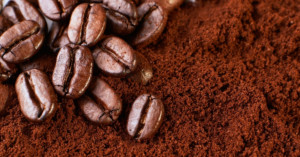
Australian researcher Dominik Kopp has developed a method to turn coffee grounds into lactic acid, which can then be used to produce biodegradable plastics. Using the waste coffee grounds, “we assembled a synthetic pathway to convert the most abundant sugar in the coffee grounds, mannose, into lactic acid,” Kopp explains. “Lactic acid can be used in the production of biodegradable plastics, offering a more sustainable and environmentally-friendly alternative to fossil fuel-derived plastics. You could use such plastics to make anything from plastic coffee cups to yogurt containers to compost bags to sutures in medicine.”
Banana (And Other Food) Waste Creates Plastic
A method of transforming banana plantation waste into a biodegradable and recyclable packaging material has also been developed.
“We were particularly interested in the pseudostems – basically the layered, fleshy trunk of the banana plant which is cut down after each harvest and mostly discarded on the field, says Associate Professor Jayashree Arcot at the University of New South Wales, Australia.
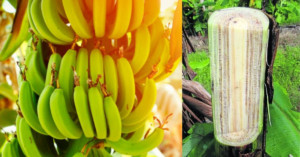
“Depending on how we pour the material and how thick we make it, we can make the trays that you see for meat and fruit. Except of course, instead of being Styrofoam, it is a material that is completely non-toxic, biodegradable and recyclable.”
Bacteria in sugars, starches and protein from discarded waste food can provide the building blocks for bioplastics: Microorganisms feed on those bacteria and produce PHAs (polyhydroxyalkanoates), which can be separated out and made into plastics. PHA is both biodegradable and compostable and can be used to create injection-moulded packaging, plastic bags, bottles, straws, food wrappers and other sustainable packaging materials.
Using waste food has the added bonus of keeping organic waste from landfill (where it produces methane, contributing to greenhouse gas emissions) and could help reduce some of the 300 million tonnes of the plastic waste produced annually. Interestingly, methane from food waste and other industrial processes, when ‘fed’ bacteria and carbon, can also be transformed into PHA.
Biodegradable materials – such as corrugated cardboard and bioplastics – have the ability to break down and decompose into natural elements typically within a year. Compostable materials – such as the aforementioned starch-based packing peanuts – break down, but also provide the earth with nutrients.
The Circular Economy
The circular economy: where everything has value and nothing is wasted.
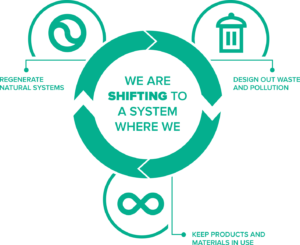
Credit: ellenmacarthurfoundation.org
A linear economy makes, uses and disposes of materials. A linear economy traditionally follows the ‘take-make-dispose’ plan. This means that raw materials are collected, then transformed into products that are used until they are finally discarded as waste. Value is created in this economic system by producing and selling as many products as possible.
The circular economy looks at all the options across the chain to use as few resources as possible in the first place, keep resources in circulation for as long as possible, extracts the maximum value from them while in use, then recovers and regenerates products at the end of service life.
It’s a win-win solution for everyone. Apart from the hope to solve the problem of climate change the ‘new’ circular economy also pledges economic growth and job creation.
By turning waste into raw materials, as discussed in the beginning of the blog, materials are kept in use and the need for virgin plastic is reduced.
The concept of circular economy isn’t a new one, though. It has been around far longer than most people may realise; for our grandparents and great-grandparents the idea of waste didn’t even exist. Everything was used and everything was considered useful. Industrialisation and the move to mass production at a global scale has meant that everything has packaging, needs to be transported long distances and requires large quantities of raw materials for its manufacturing. All of this creates growing levels of excess materials, and if those materials are not recyclable then they tend to go to landfill or to an incineration plant. Some estimates consider that humans are using resources at the current rate of 1.75 planets.
In a circular economy, it’s important to think about how we make things and the materials we use to make them. At British Recycled Plastic we support sustainable consumption and production.
British Recycled Plastic Playing A Part In The Circular Economy
By turning waste into raw materials, substances are kept in use and the need for virgin plastic is reduced. One of our main objectives is to produce goods while strongly limiting the waste of raw materials.
The idea is to ‘close the loop’ of the production cycle and maximise the recycling and re-use of material. Our business promotes new product design to facilitate the re-use of recycled materials.
Engineered from 100% British Recycled Plastic and guaranteed for 25 years, our products are tough enough to never let you down. We help public and private sector organisations and individuals lower their maintenance costs and be kinder to the environment by producing and supplying ultra-tough, maintenance-free 100% recycled plastic garden furniture, bins, landscaping and building products, raised beds for allotments and gardens, planters for parks schools and public spaces, as well as durable fencing and more.
Supplied to thousands of organisations and private homes across the UK, we believe they are the very best that money can buy.
The way plastic is normally used deems that it is bad for the environment. Unless it’s recycled, plastic is unsightly, can be fatally ingested by wildlife, can last in landfill for – as mentioned above – centuries, and in the case of some kinds of PVC in particular, can leach harmful chemicals into the ecosystem. This is why it is vital that all of us look for ways to keep recycling the existing plastic that is already in circulation. We provide a range of ultra-tough products that keep society’s plastic out of landfill and put to good use.
Our established plastic supply lines include plastic waste from the farming industry in the form of black plastic coverings found wrapped around bales of hay. You can watch a video explaining how our part in the circular economy packing process is established.
By using the Womble mentality of ‘making good use of the things that we find’ and using the mantra ‘From Waste To Wonderful’, we’re proud of how our role in the circular economy is helping to reduce landfill mass and create products that are both long lasting and beautiful.
We’re committed to widening the market for recycled, environmentally friendly alternatives to traditional materials.
Check out the website and please do contact us for more information:
01422 419 555
Sources of information used in this blog:
sciencelearn.org.nz
goodnewsnetwork.org
thedieline.com
packaginginsights.com
fdiforum.net
foodprint.org
ringvallcircularity.consulting
ellenmacarthurfoundation.org
